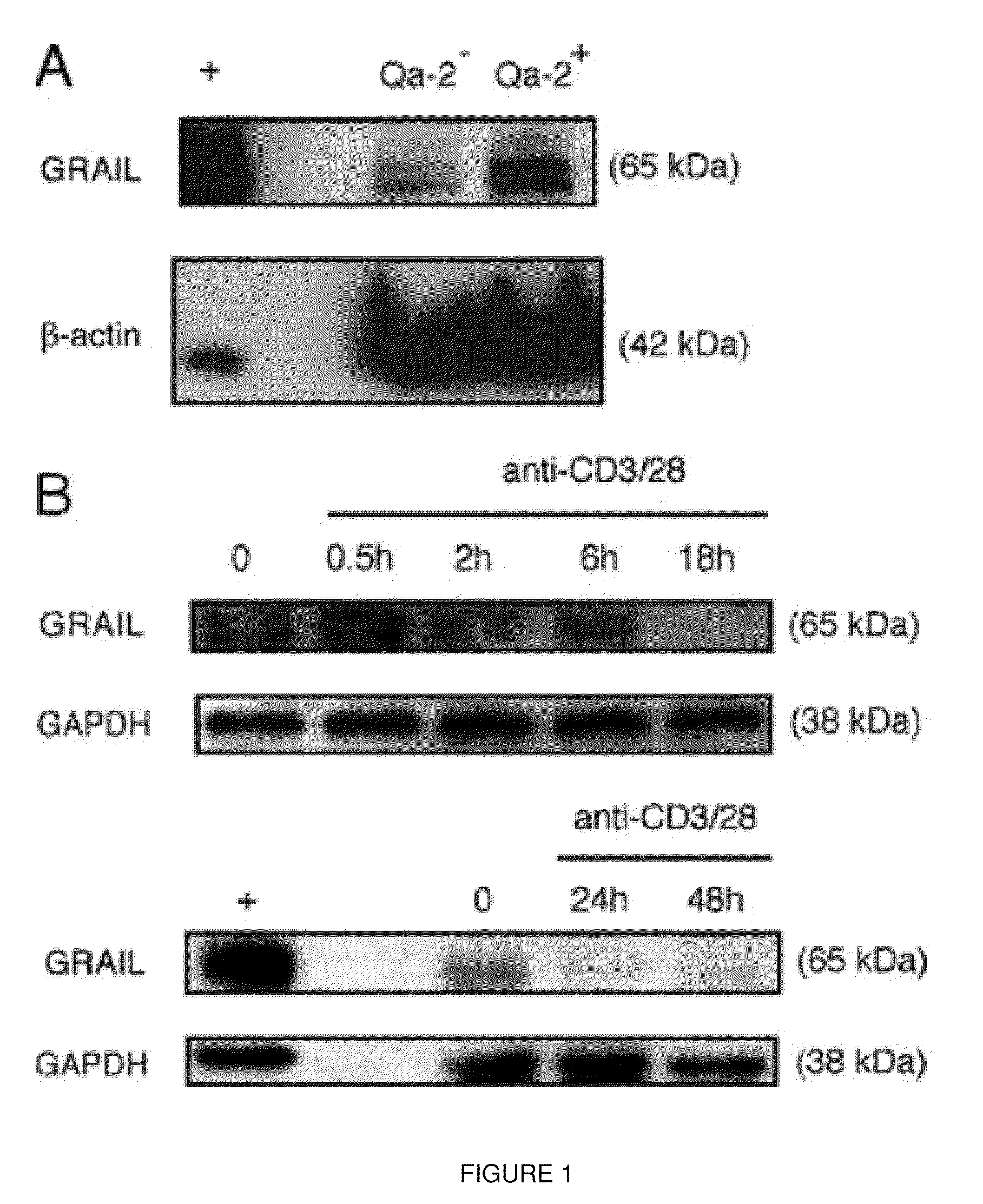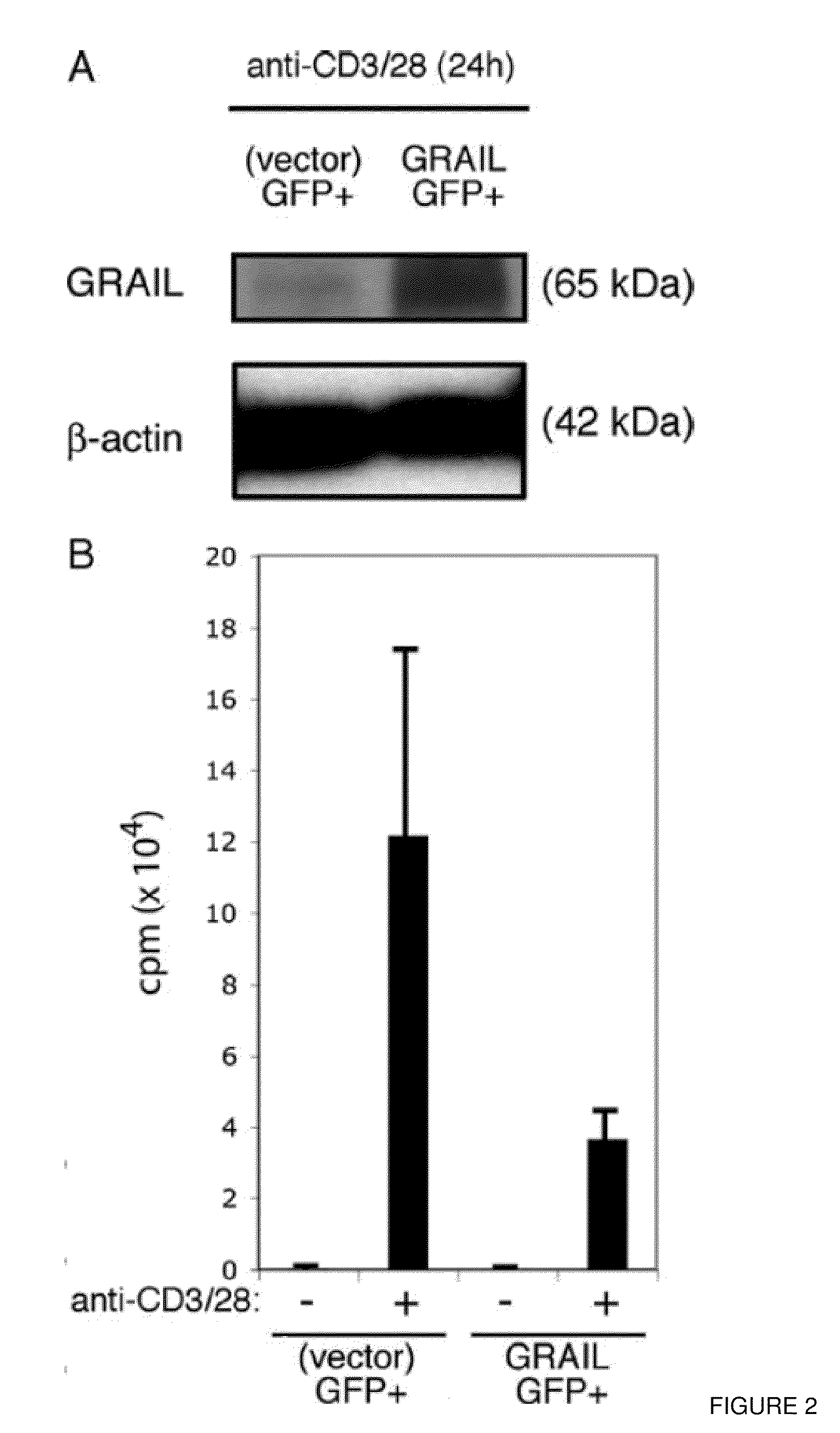Combination therapy to inhibit t cell effector function
a technology of effector function and t cell, which is applied in the direction of antibody medical ingredients, drug compositions, immunological disorders, etc., can solve the relative difficulty of suppressing established immune responses, difficult to achieve effective treatment of established immune responses, and general difficulty in controlling autoimmune diseases. to achieve the effect of inhibiting the responsiveness of cd4+ t cells
- Summary
- Abstract
- Description
- Claims
- Application Information
AI Technical Summary
Benefits of technology
Problems solved by technology
Method used
Image
Examples
example 1
Naive CD4 T Cell Proliferation is Controlled by Mammalian Target of Rapamycin Regulation of GRAIL Expression
[0093]In this study, we demonstrate that the E3 ubiquitin ligase gene related to anergy in lymphocytes (GRAIL) is expressed in quiescent naive mouse and human CD4 T cells and has a functional role in inhibiting naive T cell proliferation. Following TCR engagement, CD28 costimulation results in the expression of IL-2 whose signaling through its receptor activates the Akt-mammalian target of rapamycin (mTOR) pathway. Activation of mTOR allows selective mRNA translation, including the epistatic regulator of GRAIL, Otubain-1 (Otub1), whose expression results in the degradation of GRAIL and allows T cell proliferation. The activation of mTOR appears to be the critical component of IL-2R signaling regulating GRAIL expression. CTLA4-Ig treatment blocks CD28 costimulation and resultant IL-2 expression, whereas rapamycin and anti-IL-2 treatment block mTOR activation downstream of IL-2R...
example 2
Inhibition of Antigen Sensitized Effector T Cells
[0125]GRAIL is expressed during quiescence, lost upon activation. Naïve CD4 T cells were isolated from mouse and stimulated with anti-CD3 and anti-CD28 antibodies in vitro for the indicated number of hours (FIG. 10). Protein was collected and run by Western blot probing for GRAIL and β-actin. Effector CD4 T cells were made by first isolating from naïve mice, then stimulating with anti-CD3 / 28 for 3 days, split off and rested for 2 more days, then washed and put in fresh media for 2 additional days. Live CD4 T cells were then collected, shown to be at rest, and then activated in the same manner as described above. Protein samples were isolated and probed with anti-GRAII antibody as described in Example 1. The data demonstrate that GRAIL is last after activation of both naïve and effector T cells.
[0126]Shown in FIG. 11, naïve or effector CD4 cells were isolated as described above. The cells were assayed in a standard proliferation assay ...
example 3
[0130]Collagen induced arthritis was induced in mice according to established protocols, as described by Yaghoubi et al. (2009) J Biomed Opt. 12(6):064025; Tarner et al. (2006) Autoimmun Rev. 5(2):148-52; Tarner et al. (2003) Ann NY Acad. Sci. 2003 September; 998:512-9; Smith et al. (2003) Gene Ther. 10(15):1248-57, each herein specifically incorporated by reference.
[0131]As shown in FIG. 14, treatment with the combined agents as set forth herein, including a combination of rapamycin and PD0325901 (N-(2,3-dihydroxypropoxy)-3,4-difluoro-2-(2-fluoro-4-iodophenylamino)benzamide; see Bain, J. et al., Biochem. J. 408:297-315 (2007)). The data show that the combined treatment provides for a lower prevalence of incidence, a lower mean visual score, and a reduced paw thickness when compared to either of the agents delivered as a single entity.
[0132]All publications and patent applications cited in this specification are herein incorporated by reference as if each individual publication or p...
PUM
 Login to View More
Login to View More Abstract
Description
Claims
Application Information
 Login to View More
Login to View More - R&D Engineer
- R&D Manager
- IP Professional
- Industry Leading Data Capabilities
- Powerful AI technology
- Patent DNA Extraction
Browse by: Latest US Patents, China's latest patents, Technical Efficacy Thesaurus, Application Domain, Technology Topic, Popular Technical Reports.
© 2024 PatSnap. All rights reserved.Legal|Privacy policy|Modern Slavery Act Transparency Statement|Sitemap|About US| Contact US: help@patsnap.com










